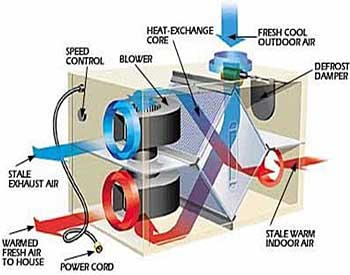Underground
Home Ventilation
When you walk through a bright and airy underground home,
it might not dawn on you at that time, but there are ventilation
systems at work there, to keep the air fresh. Subsurface
habitats need air exchange systems due to the buildup
of CO2, mold spores, tobacco smoke and sometimes even
radon in underground areas.
|
|
 Ventilation for underground home
Ventilation for underground home |
Most earth-sheltered homes have state of the art systems
for incoming air, so that it can be properly filtered.
As much as people who live "down to earth"
lifestyles like to keep things simple, a ventilation system
really should be at least partially automatic.
Exchange This, Please ...
Underground homes benefit greatly from ventilators that
recover energy. They are called air to air heat exchangers,
and they remove the polluted or stale air from your home,
replacing it with fresh air from outdoors.
In order to conserve the most energy, these ventilators
pass the warm air moving outdoors through a component
inside, a heat exchanger. There, heat that is headed outdoors
is actually transferred into the incoming air, which is
cool. This process will keep you warmer in the winter,
and save a lot of energy, since your heater won't be needed
for warming incoming cold air.
Humid Beings ...
During the summer months, the outgoing air works to cool
the warm, incoming air, which maintains comfort in warmer
weather. Ventilators that work on the energy-recovery
system can be run with humidistats or timers. Although
they tend to remove any excess humidity, you can even
set them up to add more humidity to the air in your home,
as needed.

Underground House and Ventilation
When you're looking into purchasing an energy-recovery
ventilator, keep in mind that they may sound more technically
difficult than their workings actually are. The ventilator
you want is different from a heat recovery ventilator.
In the unit you want, the heat exchanger will transfer
some water vapor into your incoming air. Heat recovery
ventilators only transfer heat.
You can keep the humidity of your earth-sheltered house
more constant when your unit transfers some moisture to
the air coming in, which is generally less humid. This
helps your home to maintain a more constant level of humidity.
The core of the heat exchanger will also stay warm, which
minimizes freezing problems in colder climates.
Breathe Light Into the Room ...
Some earth-covered homes also feature skylights that can
be opened, which is a much simpler way of allowing air
flow from the front of the house to the back. But that
system only works when someone remembers to open those
skylights. You may also see conduits or tubes in the front
of the house (below the level where they would affect
the natural look) that run from the front to the back
of the house.
Many people who dwell in earth homes also have plants,
to bring nature in. Plants generate oxygen from the carbon
dioxide we breathe out, though not on a large enough scale
to ventilate an entire house (the Biosphere in Arizona
discovered this quickly). Some homeowners may use a combination
of systems, including a "passive stack" system.

Earth Berm House with Vent on Top
For smaller homes, tubes or conduits can move air enough
to vent the structure, and with the temperature differences,
it works fairly consistently. Homeowners will sometimes
rig a mechanical assist to this system, to be sure of
proper ventilation at all times.
Conclusion ...
When planning and designing your underground house be
sure your contractor covers the ventilation system in
detail upfront. You'll breathe a lot easier if you do.
:)
Written by Kevin Knatloa
First Published on November 05, 2012
Updated November 22, 2013
External Links
Heat Exchangers and Energy Recovery Ventilators
http://www.ag.ndsu.edu/pubs/ageng/structu/ae1393.pdf
|